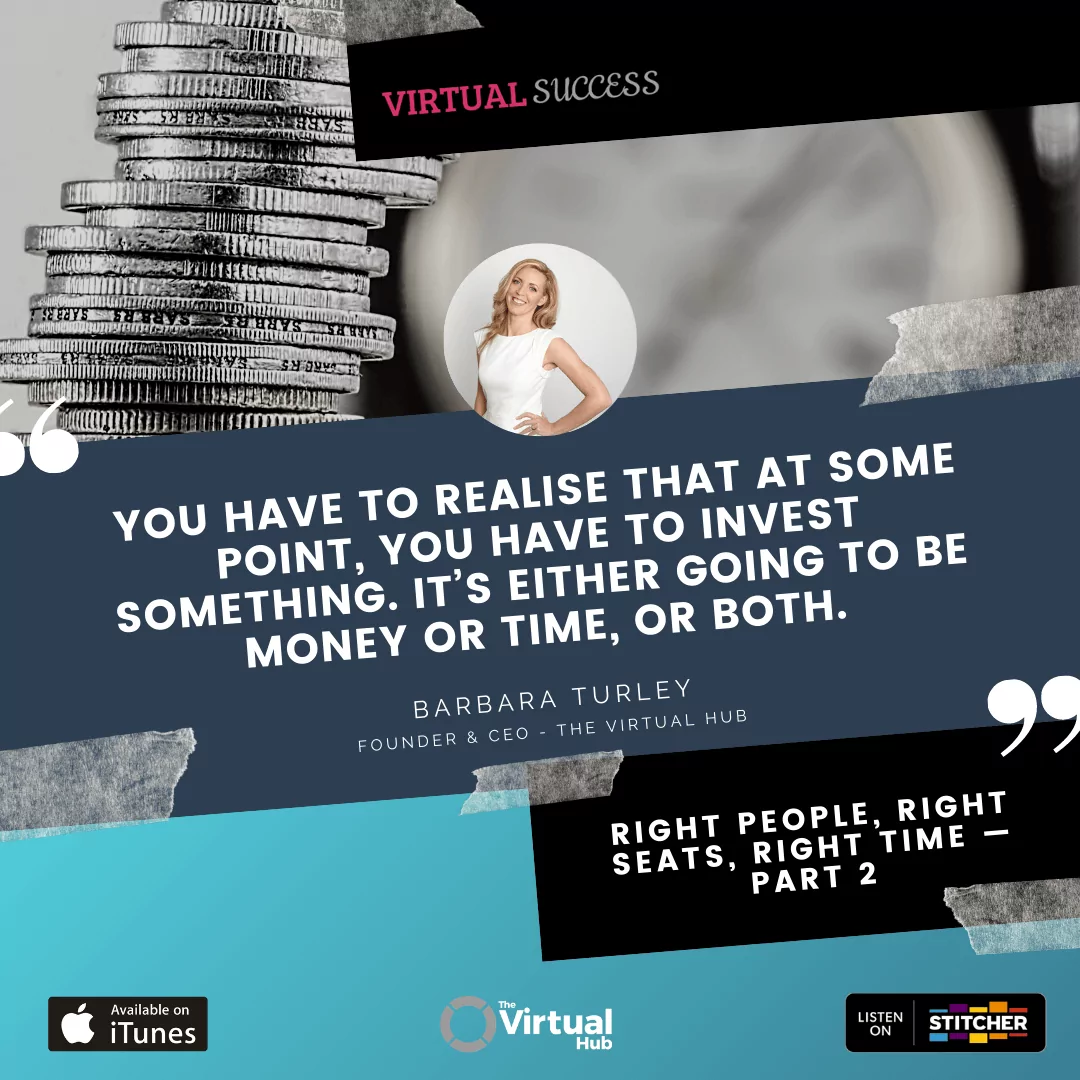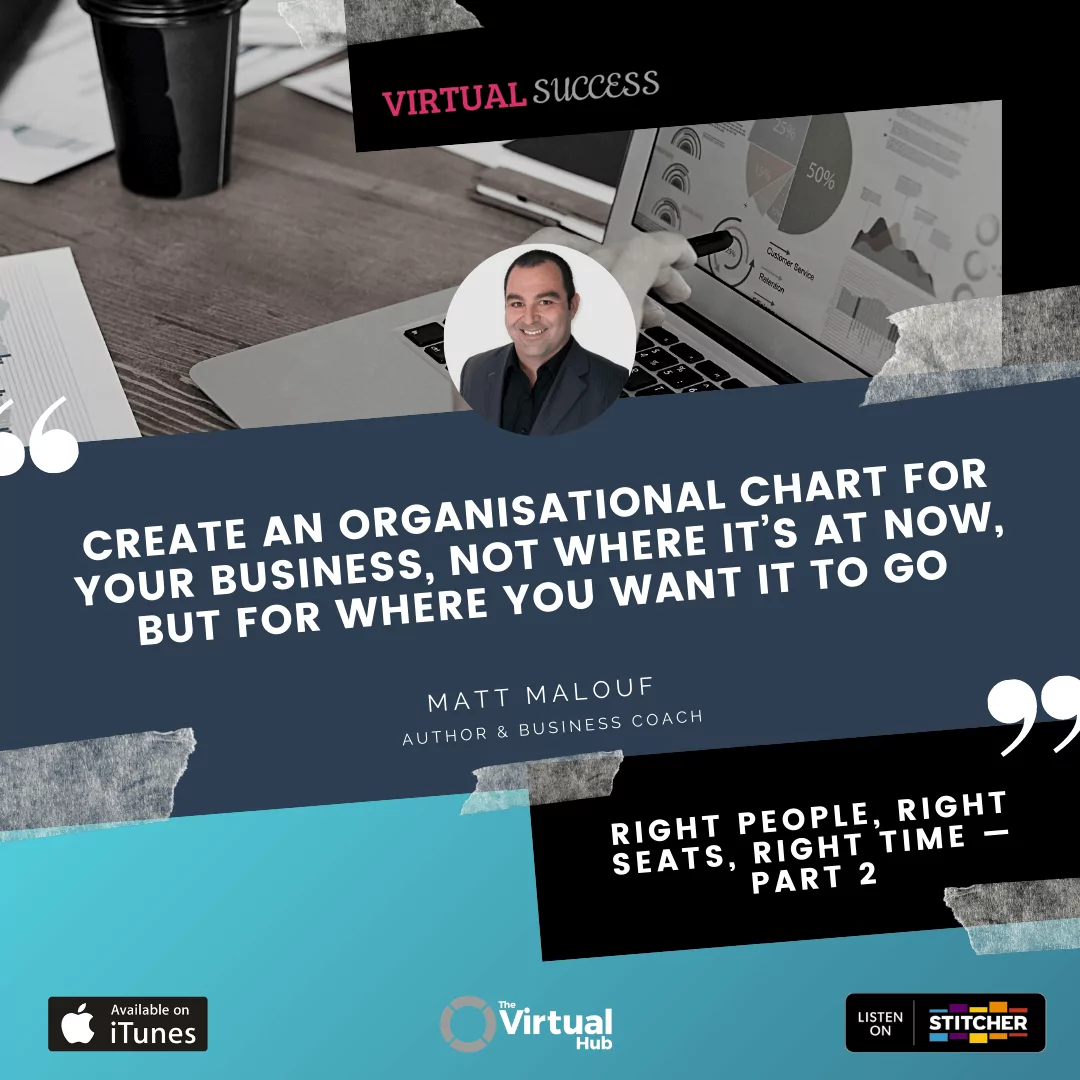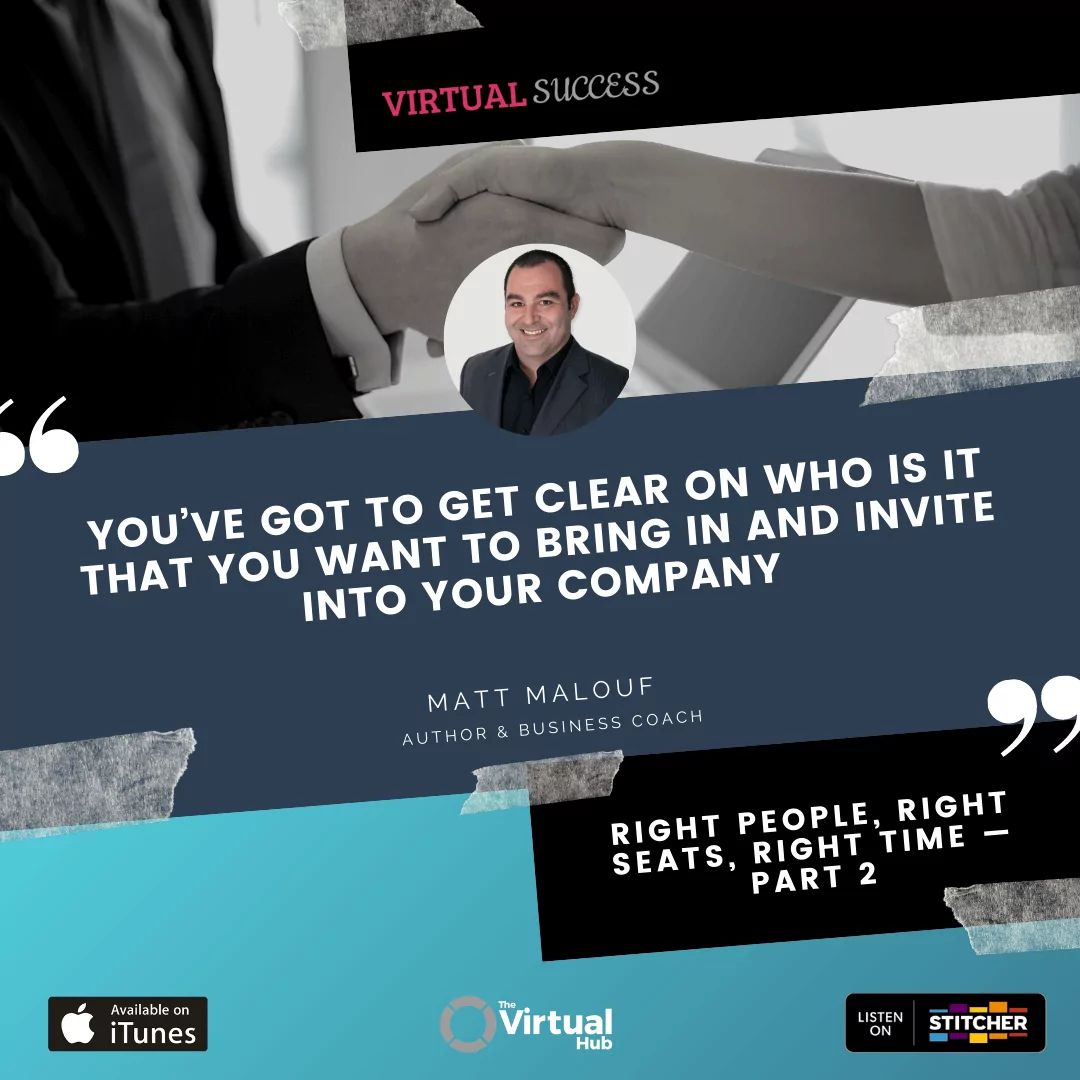Right People, Right Seats, Right Time — Part 2
Want the transcript? Download it here.
In this episode, Barbara and Matt take a closer look at some of the human resources roadblocks that business owners may come up against when taking on the task of growing their business.
During this episode, we take a look at the importance of not only finding the right people for roles within your business but making sure they are the right fit for the role and bringing them onboard at the right time.
Some of the areas covered include:
- Understanding which seats you are going to need and when you are going to need them
- The importance of mapping out your organisational chart and understanding not only where your business is now, but more importantly, where you want to take your business in the future – and planning for this
- Deciding whether you have the time and resources to train up an existing employee or bring on board someone who already has the skills you’re looking for
Let us know what your key takeout has been from this episode and join the continuing conversation over in the Virtual Success Facebook Group.
This episode is the second part of a 3-episode series. You can listen to the other parts here:
- Part 1: Do I need a VA, Project Manager or Operations Manager…or all three?
- Part 3: The Stepping Stone to Hiring an Operations Director with Sarah Noked, OBM
In this episode:
01:02 – Right people, right seats, right time
02:14 – Right people
04:24 – Skilled people vs training people
05:58 – Right seats
07:15 – Which seats you need to fill and when
13:00 – Right time 16:13 – It’s easy to do and easy NOT to do
20:18 – Wrapping things up
Matt: Hey everyone. Welcome back to another show of the Virtual Success Show. I’m joined today by my co-host, Barbara Turley. Hey, Barb.
Barbara: Hey, Matt! How’s it going? Good to do another show with you.
Matt: It certainly is, yeah. It’s such a beautiful winter’s day here in Sydney today.
Barbara: It is.
Matt: It’s clear blue skies and can you believe, 23 degrees in the middle of July, or beginning of July.
Barbara: I have to admit, I love… The Australian blue skies are just to die for. You get blue skies all the time, pretty much all the time here. It’s very rare that it’s not blue skies. I just love that.
Right people, right seats, right time
Matt: Certainly is. And it’s a really exciting day to be doing this topic as well, titled ‘Right People, Right Seats, Right Time,’ and this is a follow-on show from the last show we did where we talked about VAs or project managers or ops manager, which should you choose? And it was really interesting conversation that Barbara and I were having as we were preparing for these shows, and this topic sort of just popped out for us, because what we’ve been finding is so many of our respective clients have the mindset that they need to put people in their businesses to help them grow, but they’re not taking enough time to number one, choose the right people for what they need done.
Secondly, putting them into the right roles or seats in the business, but also then it’s about the timing of all this, and that’s what we wanted to talk to you today. So, let me get started. Barb, right people. What’s your experience as far as right people in your business and some of the challenges you’ve had over the time?
Right people
Barbara: Yeah. So, look, a lot of the things that I share on this podcast I learned myself through the hard way and not having anyone really to sort of advise me on it, but I guess a lot of these things you do learn by experience. So, in terms of the right people, I think… Look, with VAs, I felt it was a bit easier for me, because I was very clear on that boundary of what a VA does and what a VA doesn’t do.
Barbara: When I tried to… I had some VAs though that were very, very good and I realised I needed, sort of, project management help and I thought, “Well, they can do it. I mean, they’re really good. They’re great VAs and they’re on it,” and what I found was when I put them into that project manager type role, it was a bit frustrating for me and it was a bit scary for them, because all of a sudden, the expectation went to a whole other level.
Barbara: Their expectation of themselves, my expectation of them, and my expectation of the result I was going to get, and the truth is, I didn’t really get that result, because I realised they needed a lot more mentorship from me to make the transition and the problem… The funny problem was, is that I gave some of the people I made project managers, I gave them VAs to work under them, but what I found was they found it really hard to break out of the doing mindset of a VA, because a project manager’s not going to do all the doing and the grunt work, they’re supposed to be delegating. I then had to teach my VAs how to delegate and they found it quite difficult. So it was actually a… It was a hard transition there.
Matt: Absolutely, and what I find around this topic of right people also is as your business starts to grow and you start to move a lot faster, you tend to need a different level of skill in order to keep up, and to your point Barb, having the time to actually train these people. So sometimes in the infancy of your business, this sort of falls into that timing piece a little bit, which is in the infancy of your business, you tend to have a little bit more time and you can spend more time training, creating systems, and the like.
Skilled people vs training people
Matt: As your business starts to ramp up and you start to really get some great results through your marketing and selling functions, what happens is, we then want to throw more to these people or we bring new people on that we want to throw more to and then we don’t have the time to train them. So, we actually under the right people piece, need to consider, do we need to be bringing in more skilled people who have the experience and actually buy that experience into our company, versus having to train them?
Barbara: Yeah. I just want to add there as well, it’s really important to also remember, if you’re at a point in business where… Sometimes when you’re growing really fast, people think you’re making a killing and you realise you’re actually not, because the costs are growing, it’s eating your profit and all that stuff. I went through this kind of phase and I realised that while it would be lovely to hire a project manager who had all those skills, I was in a situation when I first did this where I couldn’t really do that actually, and I realised that the best thing I could do was actually take some of my own time and make the people who I knew could do it, but they just needed a bit more of my time. And I just had to invest my time, because I certainly didn’t have the money at the time.
So, sometimes you got two resources, you got money and time. Sometimes maybe investing, if you’re good at this, some of your own time, means that you can get the results, but you have to realise that at some point, you have to invest something. It’s either going to be money or time, or both.
Right seats
Matt: Correct. Correct. So then, I guess, in talking to the right seats, this is a really, I guess, undervalued piece in business, I believe, and it’s a very, very simple tool. I was saying to Barb just before the show, it’s actually a piece of advice I think I’d give out at least once a week now, which is, creating an organisational chart for your business, not where it’s at now, but for where you want it to go.
Matt: So for instance, if you’ve got goals or targets you’re trying to hit in the next one year, two years, five years, for arguments sake, you need to create an organisational chart for what the business… the team looks like, assuming you’ve hit your one-year goal, assuming you’ve hit your two-year target, assuming you’ve hit your five-year targets. So that you have clarity on the business and the team you need to grow into versus constantly being reactive, and it’s the reactive business owners that tend to put the wrong people in the wrong seats.
And so, this very, very simple tool being the organisational chart, done properly helps you future pace the… or understanding which seats you’re going to need and when you’re going to need them.
Which seats you need to fill and when
Barbara: I’m just laughing listening to you say that Matt, because I know, and just for the listeners, Matt gave me that advice a few years ago when I was… The business was a lot smaller and he doesn’t remember specifically giving me that advice, but I have actually talked about this on other podcasts where I have been interviewed and said that it was one of the most pivotal pieces of business advice that changed a lot for me, personally.
When I actually sat down and I think Matt, I think I remember you saying to me, “Barb, why don’t you do an org chart of what your business looks like at 100 people.” And at the time, I think I had 15 people and I couldn’t even get my head around that, but when I did it, I look at it now and we’re sort of at that 100 people place, and the people I was thinking of hiring when I was at 15 people were actually, in hindsight, going to be the wrong people had I not done this particular exercise.
Barbara: And the people I was thinking of hiring at 15 people, I haven’t even hired yet, because I don’t actually need those yet and it made it very clear to me what I actually needed, which in my case were things like project managers, trainers, strong team leaders. That’s the sort of thing I really needed and I’m now doing the org chart of what does the business look like at 500 people? Which is actually exciting now, whereas the first time I did it, it was a bit scary. So, massive piece of advice for anyone listening. Don’t be scared of it and just do it. Have a look at it.
Matt: Absolutely, which sort of takes us back to the last show where we talked about VA or project manager or ops manager, and when you create this organisational chart and you’re clear on what each role needs to be doing and how it all fits together, then you can start to make decisions about, “Well, who am I going to put and in which seat am I going to put them?” And this, again, it doesn’t take a lot of time and it’s not about getting this perfect.
As you grow within your business, the organisational structure will evolve as well. Like Barb was saying, who she thought she needed didn’t end up turning out to be who it was, but without that structure and that plan and that visual, it would’ve been a lot harder.
Barbara: Yeah. You just panic and you hire, you think, “I need an HR manager. I need this and I need that,” and you actually don’t. In time as the business grows, you will need all of these functions, but you know, Matt, as you were talking, I was just thinking about the stages of business and this concept of what is the right time, because people have often asked me, “When’s the right time to get a VA? When’s the right time to get a project manager?”
Barbara: And I think in the very, very, very early stages of the business, when you still haven’t even figured out the product to market fit and all that kind of thing, I think at that point of a business where it’s very much start-up and you’re still trying to get a product that people are going to buy, I think you could possibly think about a VA at that point, but I don’t… I even think that’s too early. I think at that point, you’re in the hustle, where you’re out there talking to the market and you’re going to figure out this product to market fit and whether your business has got legs. Would you agree with that, Matt?
Matt: I agree—
Barbara: It’s hustle time where it’s really you. It’s all you.
Matt: It is. Where I see a VA being able to support a business owner at that point is in the lower level, low value, admin things that tend to take up a lot of our time. And so, even… I’ve made the recommendation for a lot of business owners in that infancy phase is get a part-time person so that you don’t ever get involved in all of those… It’s all those simple, little tasks that need to get done, but can easily be handed over and done by somebody else, because it just gives you more time out there to market and sell, which is, in that early phase while you’re really in that, I guess we call it start-up or sort of ramping up phase, it’s all about marketing and sales, so the more time you can have marketing and selling, the quicker your business will grow.
Barbara: Absolutely, and then I think, just thinking about my own journey, I know it was like that initially. I had a VA and I was doing all that stuff myself. My VA was doing things like… They’re not low value, but they’re not revenue generating, so things like your social media and just keeping… making your business look bigger than it probably is at that point. You want to make yourself look like ‘we,’ instead of just ‘me.’
Barbara: But then when you’ve got a product that’s selling, so you start to realise that you’ve got a service or a product that people are buying and things start to take off a bit, I think that’s really the point where you start bringing VAs in quite a lot, when you start developing your processes and getting the engine churning. You figure out what the recurring tasks are, what is required to keep the engine of this thing now running so that you can continue to stay out there and keep flying the flag.
Barbara: At some point then, I think it’s when you’re a bit bigger that you… For me, the project manager thing is more when you realise you’ve got… You’re trying to manage too many things, there’s too many… Okay, the engine thing is going in the recurring task list, but there’s so many things that you… projects in order to drive the business forward that you’re getting caught up project managing yourself, and I think that’s the point at which you may need a project manager to help you navigate that, whereas the operations manager thing, I’m interested to know your thoughts, Matt, on whether that’s when the business is a little bit bigger? You’ve sort of gone through that start-up and early growth phase, but you’ve come into more… you’re now in this for the long term.
Right time
Matt: Absolutely. You’re certainly well into a good, consistent revenue and profitability because I think—
Barbara: There’s no going back, kind of thing. There’s no way you’re shutting this down. This is now the business. This is a fully alive dynamic entity that is growing.
Matt: Correct, but also too, I see a lot of business owners wanting to put an ops manager in too soon and they don’t have enough free cashflow to invest in the right person. So what they tend to do, and this comes back to obviously right people in the right seats, so they put a person in, asking them to be an operations manager, often because they’ve been with them the longest or there is potential there, but they’re not quite sure, but they need that seat filled. So they put that person—
Barbara: Or they have a VA who’s really good and they think, “Well, I’ll just make them the ops sort of person.”
Matt: Correct. 100%.
Barbara: Now, I will give a little tip on this. Of course in business, cashflow is hard and we’re all hustling and we’re all trying to… Not everyone can go out and spend $100,000 on an amazing ops manager to walk in and just run the whole thing for you. I did actually go the route of my first ever VA became my ops manager, but the… I took a very painful route because I’m good at coaching people and mentoring and I also am good at operations myself. So, I built her up into that, but it was a process that took about two years. For me, it was very rewarding, but it took a lot of my time. So if you’re prepared to do that, you can, but it is definitely the harder route and you want to be very good at it.
Matt: Yes. It is a “harder route,” however, if you do that exercise we talked to earlier with the organisational chart, you may actually know that in two years’ time, our intention is to have an operations manager. We’re going to employ someone with the right attitude and values that align with our business now and then—
Barbara: Grow them into that.
Matt: …Find someone who actually has a career aspiration to go into a management role as well and then groom them over the next two years, and when you can dangle that carrot to the right person, they’ll step up as much as you have to step up in your training and ability with them.
Barbara: You know Matt, I’ve realised in your saying that, I didn’t realise this, but that’s exactly what I’ve done, and because of that org chart little exercise that I did way back when, I know the roles that are coming in two years’ time and I’m already looking at my… I’m even doing it these days. I’m going, “Well, X… such and such over there is really showing skills that could be developed up into what I need in 12 months’ time.” And I—
Matt: Absolutely.
Barbara: …using it and… Like I said, I enjoy doing it, though, but for me, it’s been a really cost-effective way to get the team that I want and what I find as well, from a people management perspective, when you find somebody that wants to do that as well, just their career development is so important to them that they don’t leave you. The loyalty is massive.
Matt: Correct.
Barbara: Not all the time, but the loyalty’s huge, because they’ve grown up with you.
It’s easy to do and easy NOT to do
Matt: That’s right. That’s exactly right. Now, a little warning I want to give to everyone here, which is, everything that Barb and I are talking to today is easy to do and it’s easy not to do, and it’s so… The reality is, to do an organisational chart, you need a piece of paper and a sharpie marker and away you go, or a whiteboard, and it is very, very simple.
Matt: And I don’t want to play it down, but if you think about the silos of your business being, say, marketing and sales and operations and finance and admin and you were just to think about the various teams you need to build under that over the next one, two, five years, I guarantee within an hour, you could create those three organisational charts, but as I said, it’s easy to do, but it’s also easy not to do it. It’s easy to just put it on a list and go, “Oh, I’ll get to that later. I don’t need to worry about that right now because of where I’m at.” But as Barb mentioned for her and her business, it’s that simple sitting down, visualising it, having it there, that’s enabled her, and many businesses that I’ve consulted and coached over the years, to grow really fast, because you have a clear roadmap and path to know who do I need and when do I need them?
Barbara: Well, I think as well, it was eye-opening for me because when I did the org chart, I realised that what I thought I needed and what I then realised I needed were two very different things. So I would’ve gone, instead of right people, right seat, right time, I would’ve ended up at maybe right people, wrong seat, wrong time, so I was thinking at the time, how it came up for me, Matt, as I was saying to you at the time, “Oh my god, I desperately need an HR manager,” because we were having a lot of HR issues at the time, but now that I… I realise now that the HR manager I would’ve hired then would’ve been expensive, they would’ve been… nobody was going to join a company that small. The person I need is actually an HR manager. I’m looking now at I want to hire the HR manager that’s going to take our company to 500 people, instead of hiring someone that was only going to be able to cope with 20 people.
So I’m already thinking ahead now and going, “Well, no point in hiring an HR manager for 100 people that’s only ever done that. I need to try and inspire somebody to come in now, work with us, and take it to 500 people.” So it’s a totally different thinking.
Matt: 100%, but it’s only that you created the, I guess, the plan, the people plan, that sits around that, that you can now be thinking that way. Very inspiring.
Barbara: Well, I think the other thing I realised, just in remembering back then, I was like, “But if I have 100 people, oh my god, I need 6 team leaders, and then I’m going to need someone for them to report to, because I can’t have 6 team leaders reporting to me.” So I realised then, “Well, maybe my first team leader might be interested in developing herself into a team manager where she manages the team leaders,” and luckily enough, she was really keen to do that, but we were able to build her up into that over time.
So now we have sort of five team leaders and she manages them, but it wasn’t like one day she came to work, and I was like, “Right. Now you’re the team manager,” and she never really had any time to develop into that. We slowly developed that up.
Matt: Yeah. I’m going to… Just one thing to correct for everyone, it wasn’t luck that that happened to Barb, it was very intentional, but putting it out there and being clear on this, her business has grown into that.
Barbara: Yes. So I’m doing the org chart now for 500 people.
Matt: That’s great.
Barbara: Wow. That’s big, but it’s very helpful. So I’m definitely the test case of… Any of you guys listening, I would really urge you, like Matt’s saying it, I did it. He gave me the advice, I did it and it was one of the most pivotal things, really, for me so far in my own business journey. So it’s definitely worthwhile.
Wrapping things up
Matt: Excellent. So, I guess in just wrapping up there, the theme of today was right people, right seats, and right time, and it’s understanding that firstly, you’ve got to get clear on who is it that we want to bring in and invite into our companies, and then which seats are they best suited to and which seats do we need filled right now to continue along the journey of growth? And then what’s the right time to bring these people in and what’s the organisational chart that we’re growing into?
Because when you combine each three of those in the right balance, you’ll really be able to grow your company fast and also, too, you start to reduce the burden and stress of people, which is a big… It’s one of the, I think, biggest challenges for most entrepreneurs, is people, but when you look at it through this lens, it makes it that little bit easier.
Barbara: I think as well, just to add to that as well, I think what I see people doing a lot, I’m sure you see this too, is let’s say you’ve got a good cultural fit, you’ve got somebody who’s great, but they’re in the wrong seat, the tendency is to just get rid of them and to try and hire the right person for that seat. I would encourage people, always think, “Well, maybe we’re just not playing to that person’s strengths and there could be another seat that we don’t know we need yet that potentially that person could be awesome at,” because churning through people in your business is very expensive, very tiring, and it’s just not worth it.
Barbara: Sometimes you’ve got the right people in the wrong seats and it’s about rejigging the seats potentially, and you can just blow something wide open. All of a sudden, somebody comes alive in the right role.
Matt: Absolutely. Absolutely. Well—
Barbara: So—
Matt: Yeah, sorry. You go, Barb.
Barbara: Yeah, so I was just thinking, our next show, guys, we’re going to do is we’re going to delve more into this operations manager piece in the next show. So make sure that you look out for that, stay tuned. It is an area that a lot of businesses are struggling to get right and it’ll hold you back. It holds back the growth when the internal workings of the business are not functioning properly, because you’re putting out fires all day, so we’re going to talk deeply about that and possibly we’ll be interviewing somebody who’s going to give you some help and guidance in that area.
Matt: Absolutely.
Barbara: So, Matt, thanks again for today. Guys, make sure you give us a rating on iTunes if you can and a review, that would be great, because it helps us to get the show out to more people and we can help more people on this topic.
Matt: Excellent. Thank you, Barb. It was really good and thanks for being so open and sharing your story with everyone, too.
Barbara Oh, yeah. I hold nothing back. I’m never going to pretend it’s easier than it is.
Matt: Absolutely. Well, thanks everybody and we will look forward to joining you in our next show.
Barbara: Thanks.
(This episode is the second part of a 3-part series. You can listen more to this discussion by going to Part 3: The Stepping Stone to Hiring an Operations Director with Sarah Noked, OBM.)
The Hosts
 Matt Malouf
Matt Malouf
Matt Malouf is a passionate business coach, speaker, author and entrepreneur on a mission to help entrepreneurs around the world break the shackles of mediocrity and reach new levels of personal and business success.
 Barbara Turley
Barbara Turley
Barbara Turley is the Founder & CEO of The Virtual Hub, a company that specializes in recruiting, training and managing superstar ‘Virtual Assistants’ in the social media, digital marketing and systems automation space.





 Matt Malouf
Matt Malouf Barbara Turley
Barbara Turley